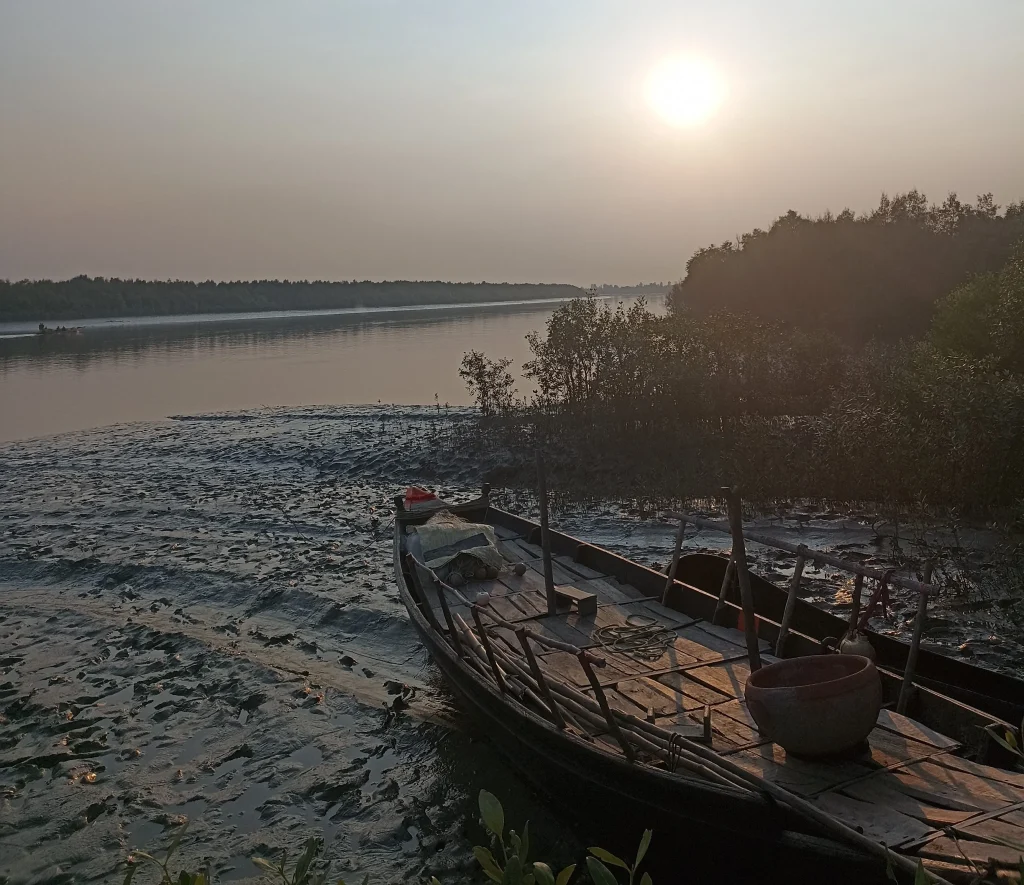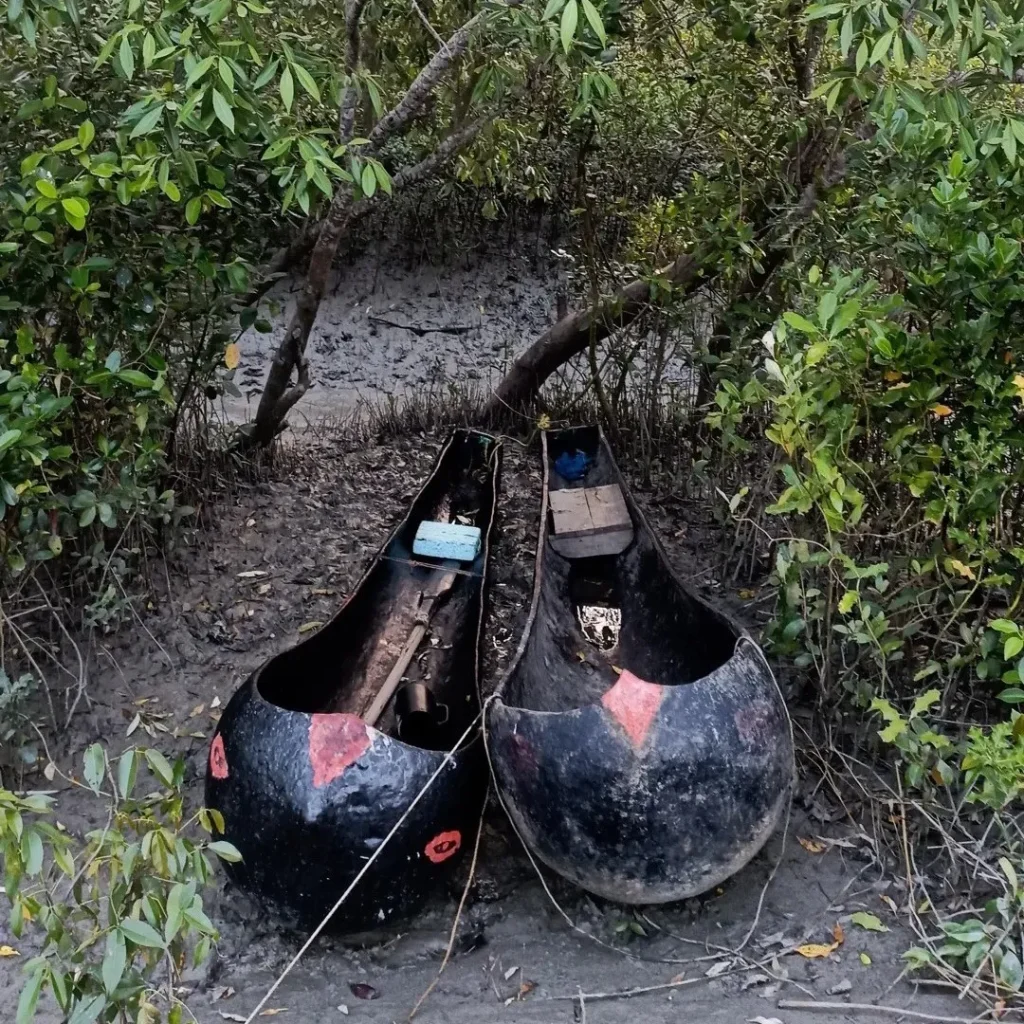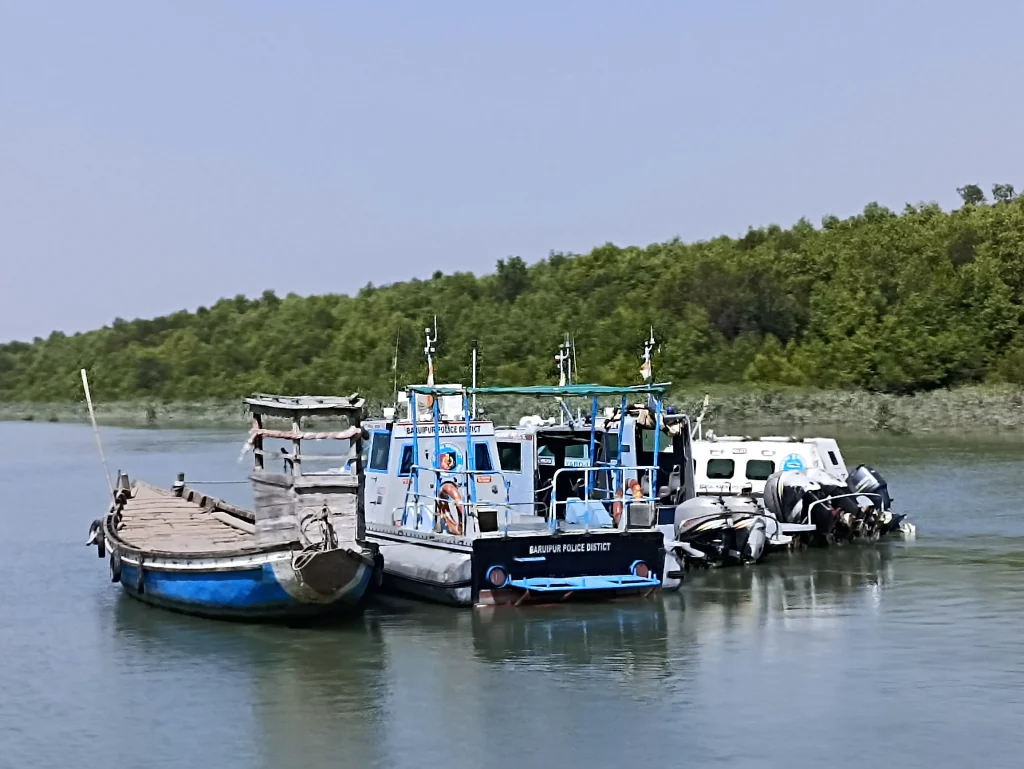Outliers: Dispatches from the Delta
by Yagnaseni Mitra
A researcher traces the movement of two migrants from the deltaic landscape of the Indian Sundarban, delving into questions around the discourse of climate refugees and ecological disaster.

Sunset, Indian Sundarban, 2023.
Courtesy of the author.
In 2023, I spent a considerable amount of time in the Indian Sundarban, working as a research assistant for the VOCAD in the Indian Sundarbans (Volunteering for Climate Adaptation and Disasters in the Indian Sundarbans) project. The project is jointly funded by the UKRI-GCRF Living Deltas Hub and Northumbria University. The study focused on volunteering and climate adaptation in the region, and conversations with locals often led to stories about migration. The Sundarban comprises mangrove forests in the deltaic region formed by the confluence of the Ganga, Brahmaputra and Meghna rivers. A greater part of Sundarban falls under Bangladesh’s Khulna Division, and the remaining—under the purview of the Indian state of West Bengal. Three out of the four protected areas of Sundarban, enlisted as UNESCO World Heritage Sites, are in Bangladesh, which is also home to the largest mangrove forest in the world.
Ever since the severe cyclonic storm Aila ravaged the area in 2009, the region has witnessed forced migration on a large scale. Experts believe that “More than 50% people living in Kolkata and its suburbs—a staggering count of 12 million—will be flooded out of their homes… This will put Kolkata at the heart of one of the biggest climate refugee challenges as inundation of Bangladesh will force millions across the border” (Mukherjee, 2015). While circumstances are not too distressing (yet), it is true that over the years, Kolkata (a metropolitan city close to Sundarban) has become home to migrant labourers and men, women and children from Sundarban who work as domestic workers. Moreover, owing to the lack of employment opportunities and lower wages in West Bengal, Sundarban’s workforce has also recently been venturing into the southern states of India, namely Karnataka, Tamil Nadu and Andhra Pradesh.

Dunga or Donga, a rare type of boat used in both the Indian and Bangladesh Sundarbans, 2023.
Courtesy of the author.
One of the most interesting people I met during multiple field visits was Krishna*, a skipper (সারেং in Bengali/boatswain), whose skill at manoeuvring the boat and spotting alluvial deposits hindering journeys on canals and/or rivers was exceptional. After arduous journeys, sometimes for a good part of the day, Krishna and I would sit on the stern and chat, while sipping hot cups of tea. (The tea tasted like liquid salted caramel, as the high salt content in the air would often result in the rims of the cups being crusted with the same. I miss that tea.) Krishna’s mother was born in the Indian Sundarban, but was married to a man living in Bangladesh. In 2009, a week after Aila had wreaked havoc, twelve-year-old Krishna and his mother returned to India, and his father and sister followed suit after selling all their land and belongings in Bangladesh. But, when I had asked him if it was climate change that compelled them to move, he said, “না। মায়ের দিদার জন্য টান। কাজের জন্য।” (No. My mother’s attachment to her mother. For work.) He paused for a minute, and added that the Indian Rupee commanded more value than the Bangladeshi Taka. I asked him if his neighbours or the other people whom he knew in Bangladesh followed in their footsteps. He said that many did—some migrated to work as sculptors, some as tailors and not everyone is involved in commercial tourism as he (is). It was interesting to me as an outsider and observer to realise that while so many were leaving Sundarban as climate refugees, marital migration within the nineteen blocks of the Indian Sundarban and intra-migration within Sundarban have also been quite prevalent over the past few decades.
In the Gosaba community development block, where Krishna resides, lived another woman whose culinary delicacies I’ve had the pleasure and privilege of tasting in the past couple of years (in Kolkata)—Kajol* Di**. Kajol Di has been working as a cook in one of my friend’s houses for two decades now. She lived in Sundarban until nearly forty years ago, and then shifted to Kolkata at the age of eleven. It was not the climate crisis or her marriage that influenced her family’s decision to relocate, much like Krishna and his family. Instead, Kajol Di and her family moved for better employment opportunities. She also mentioned that because they did not own enough land to support themselves, staying back in Sundarban was not an option. Kajol Di’s father worked as a labourer in Kolkata, and disappeared without trace when she was only thirteen! Four decades later, there is still no trace of him.
At the age of eleven, Kajol Di started working as a domestic help, and at fourteen, she was married in a neighbourhood in Kolkata where she continues to live even today. During one of my conversations with her—while she cooked my favourite palong shaaker ghonto (an Indian dish made with spinach leaves) for lunch—I asked Kajol Di whether she ever thought of going back to live in Sundarban. Without pausing a beat, she replied, “না। আমার তো শশুর বাড়ি এখানে। আমি আর সুন্দরবনে যাব কেন…?” (No. My in-laws’ house is here. Why will I go to Sundarban…?) She continued in the same vein, mentioning that if her in-laws’ had stayed there, she might have considered the same. However, she was content, visiting her own family once in a year or two. When I asked her if she misses anything specific from her childhood, she only mentioned her friends with whom she has lost touch. She said that they too have migrated to other blocks in Sundarban after getting married, and lamented the loss of their connection. For the most part of our conversation, she reminisced about growing up in Kolkata, and looked at Sundarban as an old friend she had good times with, but with whom she is not particularly interested in renewing a deeper relationship…

Baruipur Coastal Police Station, 2023.
Courtesy of the author
I remember one evening in Sagar island, standing in front of the Kapila Muni Ashram, how my supervisor/one of the lead researchers (of VOCAD in the Indian Sundarbans) had pointed out the temple spire that could be seen standing tall during the low tide, well into the waters of the Bay of Bengal. She told me that it was the old temple, not the first to be built though, but the one constructed after the old one was washed away as the waters of the Bay had engulfed a considerable part of the island. In the late 1990s, the spire of the first one could be seen quite clearly too. The second one too, lies deep in the waters, making it evident how even God doesn’t spare himself the wrath of Mother Nature. And who knows how long before the present temple, which is located about five hundred metres from the edge of the island, will be washed away too?
As I pen this, I wonder about Krishna and Kajol Di, and how they are outliers to the primary narrative of climate refugees. They and their families are also migrants, but their stories will often not be considered ‘relevant enough’ and their struggles would be conveniently relegated secondary as they aren’t climate refugees. Akin to my rendezvous with the spires of the old temples, I find myself standing at the edge of predominant discourse, willing to listen to their (hi)stories… some heard, most forgotten, and others yet to emerge.
Also read: Chronicles of Barkha
*Names have been changed to ensure anonymity.
**‘Di’ and ‘da’ are suffixed after the names of older women and older men respectively, to extend respect while addressing them. ‘Di’ implies elder sister and ‘da’, elder brother.
References:
About the author
Yagnaseni Mitra works in publication support services as an academic editor specialising in psychology and psychosocial healthcare. She works primarily with Asian authors, often through publications such as Taylor and Francis, Elsevier, Wiley, Springer etc. via Cactus Communications. At present, she is also involved in a research collaboration led by Northumbria University, titled “Volunteering for Climate Adaptation and Disasters in the Indian Sundarbans”. Yagnaseni is also experienced in transcribing and translation work (D.A.G. Museums and Newcastle University), and continues to be involved in projects with the Living Waters Museum.
She is on Instagram: @ymitra94
